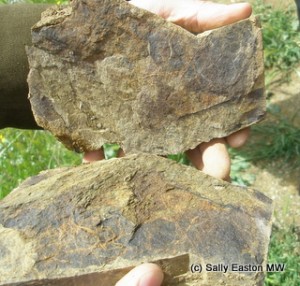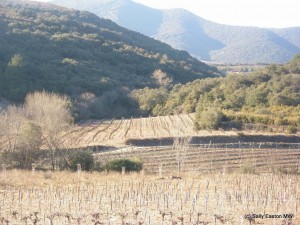In the schist
A version of this article first appeared in Winestate magazine, Nov/Dec 2012.

Priorat schist in the hands of Alvaro Palacios
France and Spain each have an appellation based on schist that produces some extraordinary, bold, yet fine-textured red wines, with suppleness and surprising fragrance to the fruit for warm regions.
They are not the only appellations with schist (Alsace, Beaujolais, Loire valley, northern Rhône, for example), but both Faugères in southern France’s Languedoc and Priorat in north-east Spain, about two hours’ drive south west of Barcelona, are based almost entirely on surface-rocky schist ground.
Schist is crystalline, layered rock similar to slate that has been metamorphosed by intense pressure. It is rich in mica and similar minerals.
Such rocky schist which glistens with quartzite crystals provides one of the defining characters for Priorat terroir. Álvaro Palacios, of his eponymous property, described his terroir, saying it is ancient “metamorphic rock, formed 5 to 50 kilometres under the earth’s crust where two horizons of limestone had compacted a layer of clay.” Subsequent tectonic movement have brought it to the surface. Palacios added “it has three times more metals and minerals than sedimentary rock” that has not undergone metamorphosis.
Palacios, along with René Barbier, is arguably the most famous Priorat vintner. Both were part of the 1990s revolution that turned Priorat from a forgotten and disintegrating backwater to a vinous temple. While Barbier makes Clos Mogador, Palacios makes Finca Dofi and L’Ermita. Barbier said his “wines are built on the basis of terroir, so the minerality and the tannins are interwined.”

Faugères
Faugères is little different. Paul Gordon of Domaine la Sarabande said schist “is a boney soil, and once the vines are established, roots can go six metres down.” And the schist, he said, gives the wine minerality. This is a point picked up by consultant winemaker Hélène Rosello, who said “Faugeres is special because of the schist, giving wines with minerality, and with fruits and tannins that are soft and sweet in the mouth.”
It was this schist that drew Aussie Jem Harris to the region. He said “the poor soil forces roots deep into the ground, so you get a notion of terroir. It imparts a certain amount of mineral focus, of graphite,” adding the schist “holds the heat of the day and releases it back during the night.”
Indeed the warmth during both day and night is important for both Priorat and Faugères. The grape varieties need warmth to ripen successfully. It’s one of the reasons tempranillo doesn’t do so well in Priorat – it’s just too hot in most spots. In Faugères, Brigitte Chevalier of Domaine de Cébène went as far as to say “mourvèdre on schist is the best pairing you can find. Schist softens the impetuousness of mourvèdre when it’s young. It gives ripe, spicy notes, specific fruits to mourvèdre, and it will age for years.”
Possibly unsurprisingly, both appellations are based on a broadly similar blend of black grape varieties including carignan and grenache as major components in both, plus cinsault, mourvèdre and syrah in Faugeres, and international cabernet sauvignon, merlot and syrah in Priorat. Both appellations are also, coincidentally around the same size at 2,000 hectares.
Both regions can be pretty dry too in summer, Priorat has less than 400mm of annual rainfall, but a characteristic of schist are the fine clays held between the layers of rock. These retain moisture for vine roots to search out and use over the growing season.
Where the regions differ hugely is in the fashion stakes. Priorat wines have reached the repute of much-sought-after, and many have the prices to match. In 2000 it became only Spain’s second DOCa, alongside Rioja, the highest level of appellation possible. On the other hand, Faugères fundamentally lacks the trend status of Priorat. However, given that Priorat’s fortunes reversed just a generation ago, perhaps it won’t be that long before the wines of Faugères are equally famed.



